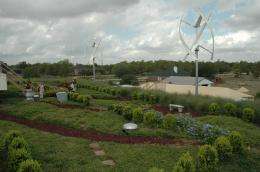Green roofs save money, energy but challenge Texas plants

When contractors talk of green buildings, they mean environmentally friendly and energy saving.
Add agricultural experts in the plans, and “green” also means plants – vibrant ornamental grasses, shrubs and flowers in park-like settings on the roofs of multistoried office buildings in cities.
“These green roofs actually will help mitigate problems in the urban areas like what people call having an urban heat island,” said Dr. Astrid Volder, Texas AgriLife Research horticulturist in College Station. “Urban areas are usually a lot hotter than rural areas, so having plants on your roof will actually facilitate cooling.”
Volder is studying the viability of green roofs with a team of researchers, Texas AgriLife Extension Service agents and Master Gardeners, and a commercial building company in Houston.
She said the green roof concept has “actually been around for thousands of years” and has been used in Europe for decades for the insulating ability, both to keep homes cooler in the summer and warmer in the winter.
In the U.S., the green roof industry grew by 28.5 percent in 2010, up from the 16-percent growth recorded in 2009, according to the annual survey by Green Roofs for Healthy Cities, a non-profit network of public and private entities that promote research and implementation of such systems in North America.
So why not in Texas?
“We’re thinking that green roofs could be really, really good for Texas because of the insulating properties of the roof that could cool buildings,” Volder said. “That could be wonderful in the summer for Texas buildings to provide additional cooling and reduce energy usage.”
But there’s a challenge.
“The problem with Texas is finding plant species that can survive in such a harsh environment,” the horticulture researcher said. “A plant growing on a roof is going to receive a lot of solar radiation, very high light conditions and not a lot of rain. And the plant is growing in maybe 4 inches of soil on the extensive-type green roof.
“My part is to look at what plants may work on top of a green roof and also how some of these plants contribute to some of the properties of the green roof,” she added.
So far, she’s found that native plants don’t fare well in roof beds because their ability to withstand heat and extended dry periods comes from their deep, extensive root system, which is not possible in shallow rooftop systems. So far, several species of sedum and some ornamental grasses are better choices, Volder said.
Her studies took a four-story leap when the AgriLife Extension’s Master Gardener program led to a set of multi-storied structures built by Jacob White Construction Co. in Houston. These buildings, from two to four stories tall, all have green roofs of various ages. The company’s CEO Jeff Mickler welcomed the team to collect and measure plant materials and water from his rooftop gardens.
Mickler already has extensive data on his green roofs which are from three to six years old.
“We’re able to cut the energy usage with our roof down by about 50 percent,” Mickler said. “Our electric bill in September for our headquarters building was $700. It’s 11,000 square feet, and we run 18 hours a day, seven days a week. And so it uses a small amount of energy.”
He said the building’s management system, which measures conditions “thousands of times per second,” in the hot, dry summer this year recorded a high of 138 degrees on top of the soil while the bottom of the soil never got above 85 degrees. The company also collects water from parking lot and building runoff into large cisterns and uses it to sprinkle the roof garden at noon and 2 p.m.
“We can see the temperatures right at noon when we begin sprinkling, go from 138 degrees down to 87 within 20 minutes,” Mickler said. “So the impact on cooling the building is that we’re only cooling from 85 to 72 instead of 140 to 72. That means we use a tremendously less amount of energy to keep the air cool.”
While Mickler’s company is realizing the economic benefit of green roofs, Volder and her team are seeking the right mix of plants and water to potentially help such systems become more commonplace across the South.
One concern being examined by the scientists pertains to water quality, given that water from parking lot and building runoff may be continuously recycled, which could potentially concentrate contaminants that hinder plant growth, according to Dr. Jacqueline Aitkenhead-Peterson, AgriLife Research urban nutrient and water management scientist in College Station.
In looking at the chemistry of water samples, Aitkenhead-Peterson has already keyed in on salinity which can severely stunt or kill plants if levels are too high.
“What I am finding, based on four roofs that have varied ages, is somewhat surprising in that the amount of salinity has not increased over five years,” she said. “I find that very exciting.”
Ultimately the researchers plan to do some modeling to determine the impact a higher number of rooftop gardens would have across Houston in terms of energy savings and perhaps help the public see the benefit of retrofitting existing rooftops into gardens.
“People have to see that the initial upfront cost is going to be useful and that they might earn it back over a conceivable period of time,” Volder said. “And that takes some vision beyond the next five-year period.”
Provided by Texas A&M AgriLife


















